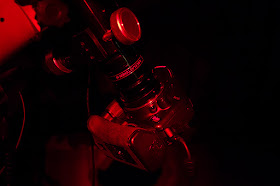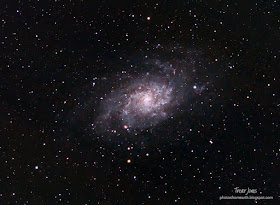I have managed to image the Triangulum Galaxy from my backyard for multiple nights over the course of nearly a week. I can't remember the last time we have had such a long stretch of clear night skies in the Niagara region. Mind you, these clear nights occurred during weekdays, and I have to be up early for work (and to walk the dog) early each morning. Needless to say, I haven't been getting much sleep lately.
My first imaging session was on the night of September 16th. Smack-dab in the middle of the work week. I didn't originally intend to shoot the Triangulum galaxy that night, I started with IC1396. The Elephant's Trunk nebula is a concentration of interstellar gas and dust within IC 1396, located in the constellation Cepheus.
This area of the night sky is in a perfect spot for imaging at this time of year from my location, almost directly overhead. I captured 38 frames on this DSO on Wednesday night. The subs were 4 minutes each using ISO 800 on my aging modified Canon Xsi.
IC 1396 - Including the Elephant's Trunk nebula

IC 1396 - Photo Details
Telescope: Explore Scientific ED80 with WO Flat III 0.8x FR/FF
Mount: Skywatcher HEQ5 Pro Synscan
Guiding: Meade DSI Pro II and PHD Guiding
Guide Scope: Orion Mini 50mm
Camera: Canon EOS 450D (Modified)
ISO: 800
Total Exposure: 2 Hours, 24 Minutes (36 x 240 seconds)
Processing Software: Deep Sky Stacker, Photoshop CC
Support Files: 15 dark frames
The Elephant's Trunk nebula can be seen in the top center-right of the photo above. It is a dark patch with a bright, sinuous rim. The rim is the surface of a dense cloud that is being illuminated and ionized by a very bright, massive star. Faint objects like this are difficult to image from light-polluted skies in the city. I found myself battling with horrible gradients and noise when processing this image. I will likely add more time to the Elephant's Trunk Nebula during the weeks that surround the new moon in October. Another 4 hours should help me pull out more detail with less noise.
 |
| Canon xsi attached to my telescope for astrophotography - lit by a red headlamp |
The following 2 nights of the week were also clear, and I took full advantage. This time, I shelved my plans for the Elephant's trunk, and focused all of my efforts on Messier 33. I captured an impressive 49 subs the following night at 5 minutes each, and then I added another 17 light frames the night after that!
My total number of frames on this object was now over 100! That's a lot of imaging in one week. All that was left now was to stack and process all of the data acquired. I set Deep sky stacker to use "the best 90% of frames" to register and stack, which resulted in a final stack of 84 images total, or exactly 7 hours. I even had success with my creation of flat and bias frames. I shot the bias frames through the telescope with the lens cap on, at the fastest shutter speed my camera allows (1/4000 of a second). The flat frames were created by shooting through the telescope, pointed at the early morning blue sky. These were shot with the camera in Av mode. I shot separate bias and flat frames for each night, except the first. Only dark frames were used for that imaging session.
Processing a photo with 7 hours worth of data is quite enjoyable. There is less noise, and more detail than I am used to. As with all of my astrophotography images, I am sure I will re-process my photo of Messier 33 several times until I feel like I have done the galaxy justice. Everyone has their own taste, and at the end of the day, you have to be happy with it.
BackyardEOS 3.1
I finally purchased a copy of BackyardEOS 3.1 Classic Edition. My trial period has ended, and I am very happy with the software. The focus and framing tab, dithering control, and file organization features are my favourite, and make me wish I had upgraded to this software a lot sooner. I always had a hard time getting accurate focus using the live-view function of my DSLR. The focusing function built-in to BackyardEOS allow you to view a digital readout of the star size in real-time as you focus your telescope. The lower number you see on-screen, the better your focus! The filename for each sub lists the ISO, object name, exposure time, date and even the temperature! This is extremely handy when stacking a large number of frames from multiple nights.
I would love to here what you think of my results for this galaxy image. You can also follow me on twitter to see more of the "behind-the-scenes" stuff from the backyard. As always, if you have any questions about the equipment I used, or my processing techniques, please leave a comment below. Thank you so much for visiting my website.
M33: Triangulum Galaxy - Photo Details
Telescope: Explore Scientific ED80 with WO Flat III 0.8x FR/FF
Mount: Skywatcher HEQ5 Pro Synscan
Guiding: Meade DSI Pro II and PHD Guiding
Guide Scope: Orion Mini 50mm
Camera: Canon EOS 450D (Modified)
ISO: 800
Total Exposure: 7 Hours (84 x 300 seconds)
Processing Software: Deep Sky Stacker, Photoshop CC
Support Files: 20 darks, 20 flats, 20 bias




No comments:
Post a Comment